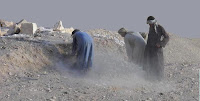5.1: Artefact Hunting on Stratified Sites
In the public imagination, 'archaeological looting' of stratified sites is only something that mainly happens abroad. Unfortunately, there are a lot of cases where archaeological sites with preserved stratification are dug into by artefact hunters looking for collectable items in the UK too. An attempt to dissuade artefact hunters from doing this was the Code of Practice asking metal detector users to respect certain principles:
Being responsible means [...] Working on ground that has already been disturbed (such as ploughed land or that which has formerly been ploughed), and only within the depth of ploughing. If detecting takes place on pasture, be careful to ensure that no damage is done to the archaeological value of the land, including earthworks. Avoid damaging stratified archaeological deposits (that is to say, finds that seem to be in the place where they were deposited in antiquity) and minimise any ground disturbance through the use of suitable tools and by reinstating any ground and turf as neatly as possible. Stopping any digging and making the landowner aware that you are seeking expert help if you discover something below the ploughsoil [...]The media however are full of accounts of recent discoveries where an artefact hunter has dug into stratified deposits to retrieve artefacts. Sometimes this has been done 'blindly', on the off-chance of finding something. More often than not it has been because a metal detector has shown there is a large metal mass deep down. Here, a classic case of an important Roman temple site at Wanborough, looted in 1984 onwards to obtain collectable and saleable finds, most of which disappeared without trace or record:
 |
| Excavations reveal the damage artefact hunting had done to a Roman temple in Surrey |
 |
| Not Best Practice by anybody's standards, Medway History Trashing in progress (Kent Mercury) |
 |
| Hoard dug out willy-nilly from below plough level |
 |
| Scotty's Bellingham Dig (screenshot) |
 |
| Holt diggings by metal detectorist trying to get the rest of a hoard but trashing its context (screenshots) |
Tamara Kroftova comments:

"In the photos on this page we see the utter destructiveness of the idea that archaeology is just about "digging up old things" and that digging holes into archaeological sites is something that you don't need any specialist knowledge to do ("anyone can do it"). The fact that none of the people shown here (and in many, many more videos of so-called "citizen archaeologists "having a go") have the slightest idea that there is anything to be ashamed of in the destructive ransacking of the archaeological record is a huge indictment of British archaeology. In the same way it is disturbing that such photos can exist in the public domain and there is not the slightest outcry even from the more 'enlightened' members of the general public (or indeed "professional" archaeologists, or "responsible detectorists"). In my country we have prison sentences for people trashing the archaeological record like that. This is simply a criminal level of irresponsibility and negligence. At least if you are going to do it, do it properly, get advice, don't take on more than you can handle, THAT is taking responsibility!"

"In the photos on this page we see the utter destructiveness of the idea that archaeology is just about "digging up old things" and that digging holes into archaeological sites is something that you don't need any specialist knowledge to do ("anyone can do it"). The fact that none of the people shown here (and in many, many more videos of so-called "citizen archaeologists "having a go") have the slightest idea that there is anything to be ashamed of in the destructive ransacking of the archaeological record is a huge indictment of British archaeology. In the same way it is disturbing that such photos can exist in the public domain and there is not the slightest outcry even from the more 'enlightened' members of the general public (or indeed "professional" archaeologists, or "responsible detectorists"). In my country we have prison sentences for people trashing the archaeological record like that. This is simply a criminal level of irresponsibility and negligence. At least if you are going to do it, do it properly, get advice, don't take on more than you can handle, THAT is taking responsibility!"




Comments
Post a Comment